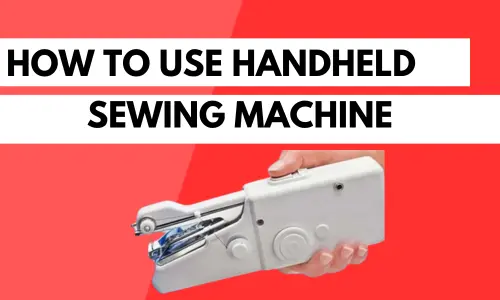How To Use Handheld Sewing Machine
A handheld sewing machine can be a convenient tool for quick repairs and small sewing projects, especially when you’re on the go. Whether you’re a beginner or an experienced sewist, learning how to use handheld sewing machine can save you time and money. In this article, we will guide you step by step on how to use a handheld sewing machine and explore its advantages and disadvantages.
- What Can You Make with a Handheld Sewing Machine?
- Step-by-Step Guide on How to Use Handheld Sewing Machine
- How to Use Handheld Sewing Machine for Beginners
- How to Use Sew Simple Handheld Sewing Machine
- How to Use a Mini Handheld Sewing Machine
- Step-by-Step Guide on How to Use Mini Handheld Sewing Machine
- How to Use My Handheld Sewing Machine
- Does Handheld Sewing Machine Work?
- Is a Handheld Sewing Machine Good for Beginners?
- Can You Sew Clothes with a Handheld Sewing Machine?
- What Are the Disadvantages of Handheld Sewing Machine?
- Conclusion

What Can You Make with a Handheld Sewing Machine?
Handheld sewing machines are versatile tools that allow you to create various items, such as:
- Patches for clothing
- Hemming pants or skirts
- Repairing seams and tears
- Adding decorative stitches to the fabric
- Creating small crafts or accessories
While the possibilities are somewhat limited compared to traditional sewing machines, handheld machines can still be useful for quick projects and repairs.
Step-by-Step Guide on How to Use Handheld Sewing Machine
To help you become more proficient in using a handheld sewing machine, follow these step-by-step guidelines:
- Gather all the necessary supplies, including the handheld machine, thread, fabric, and any additional accessories.
- Read the user manual thoroughly to familiarize yourself with the machine’s features and controls.
- Prepare your fabric by cutting it to the desired size and shape, ensuring it’s free from wrinkles and loose threads.
- Insert the thread into the machine according to the manufacturer’s instructions.
- Position the fabric under the presser foot, aligning it correctly for the desired stitching line.
- Activate the machine by turning it on or pressing the foot pedal.
- Guide the fabric along the desired stitch line, maintaining a steady pace.
- Once you’ve completed your stitching, cut the thread and remove the fabric from the machine.
- Inspect your work and make any necessary adjustments or repairs.
Remember that practice makes perfect, so don’t be discouraged if your initial attempts don’t yield perfect results.
How to Use Handheld Sewing Machine for Beginners
If you’re new to sewing or using a handheld sewing machine, here are some tips to help you get started:
- Start with simple projects that require minimal stitching, such as hemming pants or sewing small patches.
- Choose lightweight fabrics for your initial projects, as they are easier to sew with a handheld machine.
- Practice sewing straight lines on scrap fabric to improve your control and accuracy.
- Watch tutorial videos or take online classes to learn proper sewing techniques and machine maintenance.
- Join sewing communities or forums to connect with experienced sewists who can offer guidance and support.
With time and practice, you’ll gain confidence and be able to tackle more complex projects with your handheld sewing machine.
How to Use Sew Simple Handheld Sewing Machine
If you have a Sew Simple handheld sewing machine, the steps for using it are similar to other models. Here’s a general guide:
- Prepare your fabric and thread as mentioned earlier.
- Insert the thread into the machine and pull it through the needle hole.
- Hold the fabric with one hand and guide it under the presser foot, making sure it’s taut and aligned.
- Activate the machine by pressing the power button or foot pedal.
- Guide the fabric along the stitching line, keeping a steady pace.
- Once you’ve finished sewing, release the power button or foot pedal and remove the fabric from the machine.
Always refer to the manufacturer’s instructions for your specific handheld sewing machine to ensure proper use.
How to Use a Mini Handheld Sewing Machine
Using a mini handheld sewing machine is simple and straightforward. Before you begin, make sure you have the necessary supplies, including the machine itself, thread, fabric, and a pair of scissors. Here are the steps to follow:
- Prepare your fabric by cutting it to the desired size and shape.
- Insert the thread into the machine’s thread groove and pull it through the needle hole.
- Hold the fabric with one hand, keeping it taut, and gently guide it under the machine’s presser foot.
- Press the machine’s power button or foot pedal to start sewing.
- Move the fabric along the desired stitching line, guiding it carefully to ensure accurate stitches.
- Once you’ve finished sewing, cut the thread and remove the fabric from the machine.
Remember to practice on scrap fabric before starting your project to familiarize yourself with the machine’s controls and settings.
Step-by-Step Guide on How to Use Mini Handheld Sewing Machine
For a more detailed guide on using a mini handheld sewing machine, follow these step-by-step instructions:
- Prepare your workspace by clearing any clutter and ensuring you have enough room to work comfortably.
- Assemble the machine by attaching the needle and selecting the appropriate stitch length.
- Place the fabric under the machine’s presser foot, ensuring it is flat and smooth.
- Hold the fabric firmly with one hand and press the power button or foot pedal with the other hand to start sewing.
- Move the fabric slowly and steadily, following the desired stitch line.
- When you reach the end of your stitching, release the power button or foot pedal to stop the machine.
- Remove the fabric from the machine and examine your stitches. Make any necessary adjustments to the tension or stitch length.
With practice, you’ll become more comfortable using a mini handheld sewing machine and be able to complete small projects with ease.
How to Use My Handheld Sewing Machine
Every handheld sewing machine comes with its own set of instructions. To use your specific model, follow the steps provided in the user manual. If you’re unsure about any aspect of the machine’s operation, don’t hesitate to seek guidance from the manufacturer or experienced sewists. They can offer valuable tips and troubleshooting advice.
Does Handheld Sewing Machine Work?
Yes, handheld sewing machines do work, but their functionality is limited compared to traditional sewing machines. Handheld machines are best suited for quick fixes, repairs, and small sewing tasks. They are not designed for more complex projects or heavy fabrics. However, when used correctly, a handheld sewing machine can provide a convenient alternative to traditional sewing methods.
Is a Handheld Sewing Machine Good for Beginners?
Handheld sewing machines can be a good option for beginners, as they are affordable, portable, and easy to use. They allow beginners to practice basic stitching techniques and complete simple projects without investing in a traditional sewing machine. However, it’s important to note that handheld machines have limitations and may not provide the same level of precision or versatility as larger sewing machines.
Can You Sew Clothes with a Handheld Sewing Machine?
While it is possible to sew clothes with a handheld sewing machine, it can be challenging, especially for complex garments or heavy fabrics. Handheld machines are better suited for small repairs, alterations, or simple sewing tasks. If you’re planning to sew clothes regularly or work with more intricate patterns, investing in a standard sewing machine would be more beneficial.
What Are the Disadvantages of Handheld Sewing Machine?
Despite their convenience, handheld sewing machines have a few disadvantages:
- Limited functionality for complex sewing tasks
- Less precise stitching results compared to larger machines
- Difficulty working with heavy or thick fabrics
- May require frequent thread adjustments and tension settings
- Less durable construction compared to standard sewing machines
Consider these limitations when deciding whether a handheld sewing machine is suitable for your sewing needs.
Conclusion
Learning how to use a handheld sewing machine can be a valuable skill for any sewist. While they may not replace traditional sewing machines entirely, handheld machines offer convenience and portability that can prove useful in certain situations. By following the steps and guidelines outlined in this article, you’ll be well on your way to mastering the art of using a handheld sewing machine. Remember to practice, seek advice when needed, and enjoy the process of creating with this compact yet powerful tool.

Mark Wood
Hi! I’m Mark Wood! I’m a very active Sewing Machine Enthusiast and love sharing a lot of tips and advice. I have dedicated my life to those who love to sew. I have been sewing since I was a child and have always been impressed by how much power you can have over your creations with just a needle and thread. Besides that, I’m a dad, husband, and gym freak.
